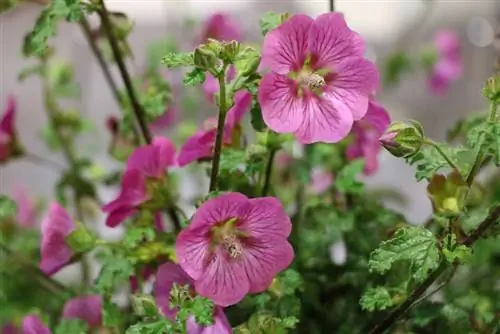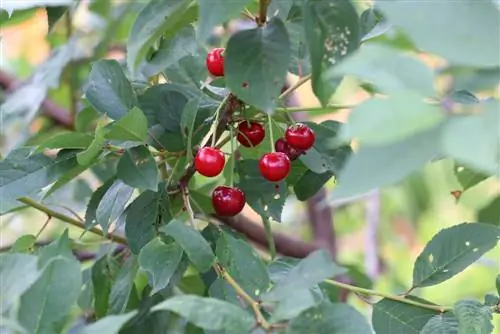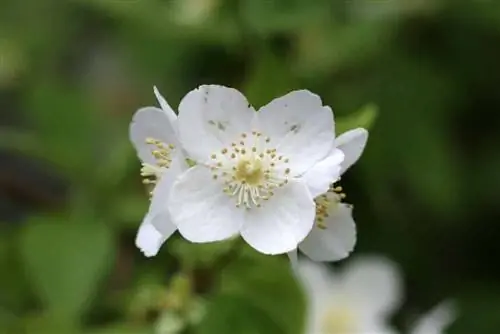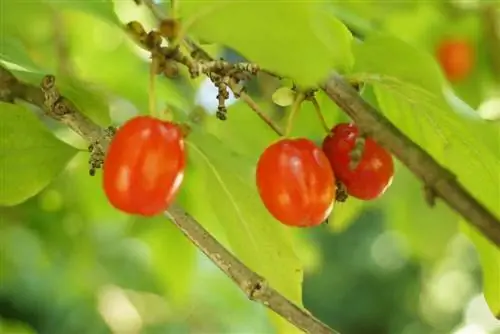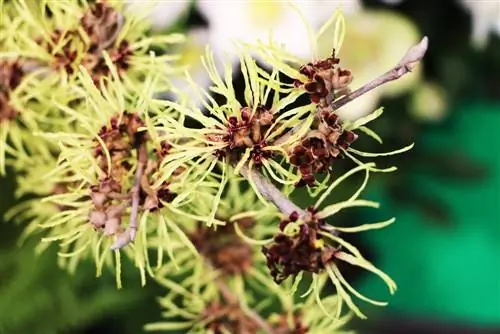- Author admin [email protected].
- Public 2023-12-17 03:39.
- Last modified 2025-01-24 12:45.
Depending on the variety, mallows can benefit from regular trimming or be seriously damaged by it. Before the ornamental plants are formed or even lightly thinned out, knowledge of the respective requirements and special features is crucial. No one has to train to become an expert botanist with a green thumb, because if the following instructions are followed and the necessary care steps are carried out afterwards, cutting the mallow is possible without any problems, even for beginners.
Blending annual varieties
Some varieties of mallow are annuals or can only be cultivated as annuals in the garden due to their sensitivity to frost. With these, there is no need for waste at all. Neither can a more lush growth be achieved, nor is a significantly changed shape possible. Only the flowering can be extended by removing the dried inflorescences in a timely manner.
To do this, each flower is cut off immediately after it has bloomed. They can also be removed with a longer stem and then used as cut flowers. This procedure makes sense for bush mallows or shrub mallows, as fruit formation begins after flowering. This process robs the plant of a lot of energy, leaving less energy for further buds and flowers.
If the mallow is a particularly beautiful specimen that is intended to beautify the garden again next year, not all of the flowers may be removed. Only if a few dried flowers remain on the mallow by the end of August or beginning of September at the latest and fruits are allowed to develop underneath can the required seeds be obtained.
Blend of perennial mallows
Mallows cultivated over several years can grow to immense proportions over time and for this reason alone require cutting. Pruning also makes sense if older bush mallows develop bare spots, the shoots become gnarled or the plant's ability to bloom diminishes.
Although a blend is always recommended for the bushy mallows, attention should be paid to the different requirements of the varieties. It is not necessary to know the exact name of the mallow. However, a simple feature of the shoots is crucial.
Woody variants
If the bush mallow is a taller growing specimen with woody shoots, the cutting is particularly easy and quick to carry out. Such varieties tolerate pruning well and can therefore be shortened radically. Please note the following points:
- Cut off all main shoots individually about a hand's breadth above the ground
- Carry out the mallow cutting on a frost-free day and not in full sun
- Use only clean and, if possible, disinfected cutting tools
- First cutting should be done in the second year at the earliest
- The shrub mallow should only be radically pruned if it is completely he althy
- For older bush mallows, it is better to use a saw than scissors to avoid squashing or shredding the shoots
Tip:
It is sufficient to radically trim the shrub mallows with woody shoots every two to four years.
Plants with tender stems
Smaller mallows, whose stems remain green and do not become woody, react much more sensitively to the clippings. Under no circumstances should you take a radical approach to these. However, blending should not be avoided entirely.
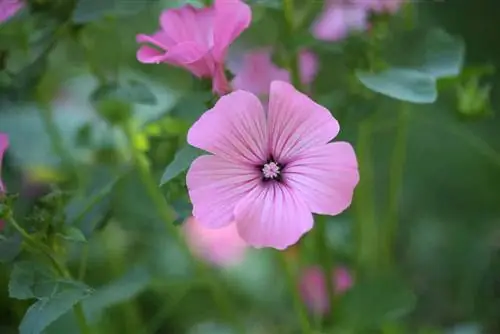
It should be noted, however, that not all shoots are shortened at the same time or that only a little of the length is reduced at a time. He althy mallows can usually cope with an all-round cut in which no more than a quarter of the shoot lengths are cut off without any problems. However, if there is a greater loss of leaf area, things become critical.
It is also possible to cut individual stems - for example those that are sticking out, bald or damaged. Even then, however, no more than about a quarter of the mass should be removed per cut.
Tip:
If you don't want to rely on your own sense of proportion, you should use a measuring tape before cutting the bush mallow and first shorten the plant's height by a maximum of a quarter of its length. From there, orientation is easier.
Topiaries
In natural gardens, bush mallow topiaries are of course not desirable, but they can be useful as a path border, hedge or decorative highlight.
The shrub mallow does not need to be radically shortened for topiary cutting. Instead, the basic shape is created first and from there only protruding shoots are corrected. In order to achieve dense growth, branches growing inwards should be shortened as quickly as possible.
Care cuts
For young shrub mallows, including varieties with woody shoots, radical cutting is often unnecessary. This only really makes sense when the plant appears lighter or has fewer flowers. In addition, the need to cut the mallow back to the ground can be delayed somewhat if regular maintenance cuts are carried out. Only shoots that are removed are:
- Damaged or broken by sun
- Have been affected by diseases or pests
- Protruding from the plant in a visually disturbing way
- Growing unfavorably inwards
- Crossing over
- Don’t plant any more flowers
- They are too woody and gnarled
- Growing too high
Time
Pruning the shrub mallow is possible both in autumn and spring. It is important that there are no temperatures below zero and that the fresh cuts are not exposed to blazing sun. Otherwise damage from frost and burns can occur.
Although spring and autumn are possible pruning times for the bush mallow, the measure should be scheduled for spring if possible. Of course, before the mallow sprouts for the first time. The reason for the spring trimming is the protective function of shoots and even the dried leaves. Mallows cut in autumn are therefore more sensitive to frost and require very dense and multi-layered protection to prevent damage from frostbite. If you cut in the fall, you have to put in a little more effort.
Different in spring. Removed from the old shoots and then cared for accordingly, the mallows can immediately sprout stronger and denser.
Subsequent care
Since cutting off the shoots - with the exception of parts of the plant that have already dried up - always represents a loss of leaf dimensions and stored energy, the mallows require a little additional care after cutting. First and foremost, nutrients are important. These can be supplied in the form of well-rotted compost, pond water, horse manure, plant manure or liquid fertilizer for flowering plants. If you cultivate and repot the plants in the pot, you can initially do without fertilizers because the substrate is fresh. The same applies when moving in the garden, with appropriately enriched substrate.
When mallow is cut in spring, fertilizer is applied immediately afterwards. If the tree was cut in the fall, the additional nutrients may of course not be administered until the following spring. Otherwise the winter rest would be disturbed and the shrub mallow could be damaged.
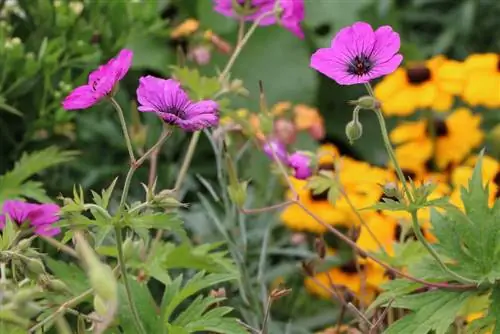
In addition to fertilization, care should be taken to ensure that the bush mallow receives sufficient water. If it only rains a little, you have to use the watering can more often. If you want to fertilize evenly and water the mallows at the same time, you can use the pond water already mentioned, which is already available when cleaning the garden water in spring. Of course, this must not be treated with chemical additives.
Pruning bush mallows
- It is cut in autumn or spring. In milder regions you can cut back in autumn. Where it gets really cold, the plant is left until spring. The stems serve as a protective shield.
- The bush mallow is trimmed vigorously. A maximum of a third of the plant remains, the rest has to go.
- A strong cut is no problem for the plants, the flowers appear on this year's wood.
- For slightly older plants (from 4 years old), you usually need a small pruning saw in addition to normal secateurs.
- If not cut, the stems will become bare and gnarled. There are significantly fewer flowers.
- Although the bush mallows don't look particularly nice after they've been cut back, that changes quickly.
- If you cut in autumn, winter protection is recommended.
- Pruning in spring is done after the last frost, before the mallow sprouts.
- After spring pruning, incorporate compost and organic fertilizer into the soil. This ensures lots of flowers and a long blooming period.
Cutting hollyhocks
- Many of the new varieties with their great flowers are unfortunately only biennial.
- It is important to remove faded and diseased or withered leaves.
- The stems usually fall over on their own in autumn and can be cut off.
- If the plant does not sprout again next year, it can also be removed.
- The plants often self-sow if the seeds are allowed to mature.
cutting prairie mallow
- Prairie mallows are popular perennials that look better every year.
- The perennial is cut off close to the ground in spring.
- Otherwise remove any dead flowers if you do not want seeds to form.
- The plant has to put a lot of energy into the formation of the seeds, which is why it often lacks it to form further flowers. It is better to only use the last flowers for this.
Pruning Marshmallow
- In spring, remove shoots that show frost damage.
- Otherwise, cut the branches back by about a third so that the plant has a nice, dense growth.
- A rejuvenation cut must be carried out every few years. All shoots that do not fit into the picture are cut out. One or two older shoots are removed to make room for new ones.
Conclusion
Pruning the mallow is not absolutely necessary, but in perennial varieties it can lead to attractively dense growth and stimulate flowering. In addition, even topiary cuts are possible if you proceed with patience and sufficient caution. If in doubt, the scissors should still rest so as not to harm the bush mallow. With the right knowledge, even inexperienced hobby gardeners can easily blend any shrub mallow according to the specific characteristics of the variety.

